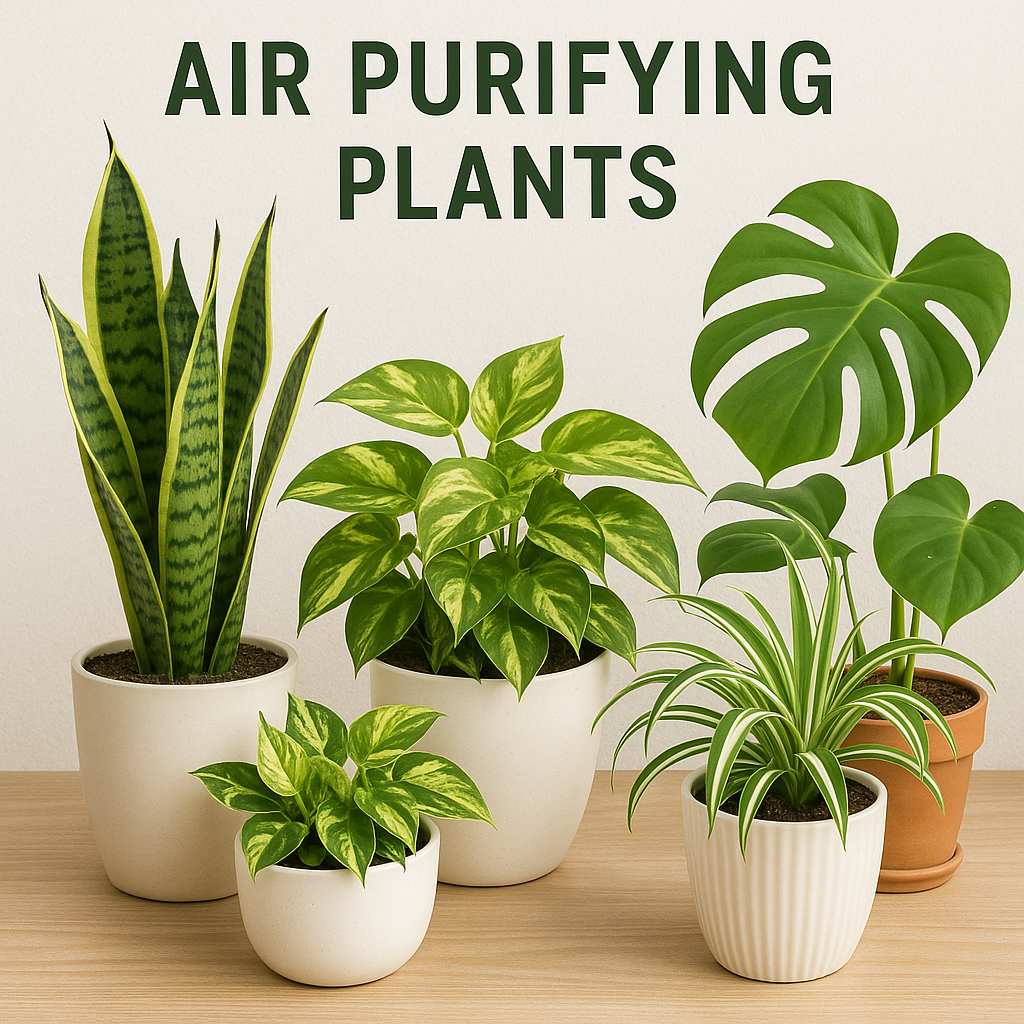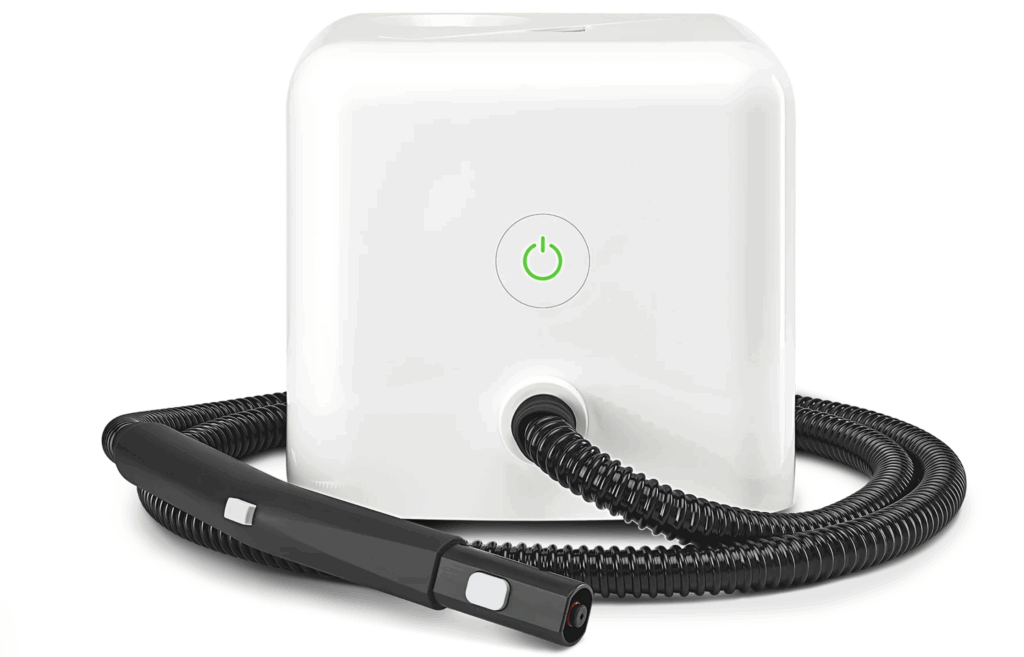Did you know the air inside your home could be up to 2-5 times more polluted than outdoor air? With most of us spending about 90% of our time indoors, according to EPA research, the quality of the air we breathe indoors is a crucial health consideration we shouldn’t overlook.
Nature has provided us with a beautiful solution: air-purifying houseplants. NASA research has found that certain common indoor plants can effectively combat “sick building syndrome“ by absorbing contaminants through their leaves and roots while converting them to harmless compounds.
In this article, we’ll explore the best air purifying plants for improving air quality, how they work through photosynthesis, and simple ways to incorporate these natural air purifiers into your home.

Best air purifying plants for your home
Adding air-purifying plants to your living space improves air quality and creates a healthier home environment. These natural air filters work continuously to remove toxins while adding beauty to your interior spaces.
How Plants Clean Indoor Air
Plants purify indoor air through a combination of natural processes. During photosynthesis, plants absorb carbon dioxide and release oxygen—the opposite of human respiration. Beyond this basic exchange, many plants also filter harmful volatile organic compounds (VOCs) like benzene, formaldehyde, and xylene through their leaves and roots.
The soil microorganisms surrounding plant roots play a significant role in air purification too. These naturally occurring bacteria and fungi use airborne pollutants as food sources, converting toxins into harmless compounds. For maximum air-cleaning benefits, expose as much soil surface as possible by removing lower leaves on your plants.
Most effective air-purifying plants come from tropical forest environments where they evolved to thrive in filtered light beneath tree canopies. This adaptation makes them particularly efficient at drawing in surrounding air and processing it with minimal light—perfect for indoor conditions.
NASA’s Clean Air Study and Its Limitations
NASA’s groundbreaking clean air study first highlighted certain plants’ ability to remove indoor air pollutants. Researchers tested common houseplants to identify which varieties most effectively eliminated toxins associated with “sick building syndrome.“ The study suggested that living plants could be integrated into biological life support systems for space stations due to their air-purifying capabilities.
These plants are so efficient at cleaning air that NASA plans to include them in biological life support systems aboard future space stations!
Best Air Purifying Plants for Your Home
Let’s explore the top performers for cleaner indoor air.
Snake Plant (Sansevieria)
The snake plant is a gem among air purifying plants, thanks to its gorgeous, upright leaves and super easy care needs! It’s great at filtering out formaldehyde and benzene from your indoor air, and guess what? It even releases oxygen at night. Most plants take a break and release carbon dioxide after dark, but not this plant. Snake plants love low light and don’t mind if you forget to water them now and then, making them perfect for busy homeowners or anyone just starting out with plants. You can pop them in your bedroom or any cozy corner of your home for a little extra air freshening magic, day or night!
Spider Plant (Chlorophytum Comosum)
Spider plants are among the most forgiving air purifiers you can grow indoors. Their ability to remove carbon dioxide, formaldehyde, and xylene makes them excellent allies for cleaner air. These resilient plants store extra food and moisture in their thick white roots, allowing them to survive in various conditions with moderate to indirect sunlight. They’re also non-toxic to pets, making them safe additions to any household. For maximum air-cleaning benefits, display them in hanging baskets where their cascading “spiderettes“ can have more surface area to filter toxins.
Peace Lily (Spathiphyllum)
Peace lilies rank among the most efficient air purifying plants, targeting alcohols, acetone, trichloroethylene, benzene, and formaldehyde. Their high transpiration rate both purifies and humidifies indoor air, making them ideal for dry environments. With elegant white flowers and glossy green leaves, peace lilies thrive in low light and humid conditions—perfect for bathrooms and laundry rooms where they can filter VOCs from cosmetics, hairspray, and cleaning products. Water them weekly with distilled water for best results, but keep them away from pets as they’re not pet-friendly.
Boston Fern (Nephrolepis Exaltata)
The Boston fern excels at air purification, ranking among the top performers in NASA’s studies. These lush plants are particularly effective at removing formaldehyde and acting as natural humidifiers, making them excellent choices for people suffering from dry skin in cold weather. Boston ferns prefer indirect light and frequent misting to maintain humidity. Their graceful arching fronds add visual appeal while working hard to clean your indoor air. Place them in bathrooms or other spaces where they can benefit from higher humidity levels.
Aloe Vera
This succulent does double duty in your home—purifying air while offering healing properties. Aloe vera effectively filters formaldehyde and benzene from indoor environments and requires minimal care, making it ideal for beginners. Simply place it on a sunny windowsill or desk and water when the soil looks dry. As a bonus, the gel inside aloe vera leaves serves as a natural remedy for minor burns and scrapes. This organic healer makes an excellent addition to kitchens where it can help neutralize cooking fumes while being readily available for first aid.
Bamboo Palm (Chamaedorea Seifrizii)
Also known as the parlor palm, the bamboo palm excels at filtering formaldehyde, benzene, xylene, and chloroform from indoor air. These tropical plants can grow up to 12 feet tall, allowing them to purify air on a larger scale than most houseplants. Bamboo palms prefer bright, indirect light but can tolerate shadier conditions, and they’re completely non-toxic to cats and dogs. Their lush, feathery fronds instantly add a tropical feeling to any space while working continuously to clean your air. Remember to keep the soil consistently moist but not waterlogged for optimal growth and air-filtering performance.
Choosing the Right Air Purifying Plants
Selecting the perfect air-purifying plants for your home depends on several key factors. The right combination of plants can maximize air detoxing benefits while complementing your space aesthetically.
Matching Plants to Your Space Size
- Plant Size Matters: Choose plants based on your room size.
- Large Spaces: Use big plants like the Areca Palm for better air filtering in larger areas.
- Small Spaces: Opt for smaller plants like the Lemon Button Fern for compact air purification.
- Grouping Plants: Clustering multiple small plants improves toxin removal, as research shows diverse species are more effective than single types.
Light Requirements and Placement
- Most effective air-purifying plants come from tropical forests and do well in filtered light.
- Snake Plants and Chinese Evergreens are great for low-light rooms.
- Boston Ferns and Spider Plants work better in bright, indirect sunlight.
- Maximizing soil exposure by trimming lower leaves can improve purification.
- For homes with pets, keep non-toxic plants like Spider Plants where pets can reach, and place toxic varieties out of their reach.
Care and Maintenance Tips
Nurturing your air purifying plants doesn’t need to be complicated. With proper attention to a few key elements, your green air filters will thrive while continuously cleansing your indoor environment of harmful pollutants.
Watering and Humidity Needs
Air purifying plants have varying water requirements that directly impact their ability to filter toxins. Most tropical air purifiers like Peace Lilies appreciate consistent moisture, while succulents such as Snake Plants prefer their soil to dry out between waterings. We’ve found that touching the soil surface works better than following a strict schedule—water when the top inch feels dry for most varieties. During hot summer months, increase watering frequency, while cutting back during winter when plant growth naturally slows.
Humidity levels significantly affect your plants’ air-cleaning efficiency. Boston Ferns and Peace Lilies thrive in higher humidity environments (50-60%), making bathrooms and kitchens ideal locations. For drier areas of your home, consider grouping plants together to create a microclimate or using a small humidifier. Misting leaves occasionally helps tropical varieties but isn’t necessary for drought-tolerant options like Snake Plants and ZZ Plants.
Soil and Fertilizing Requirements
- Use well-draining potting mix designed for indoor plants to enhance detoxing abilities.
- Opt for organic potting soil free of synthetic chemicals to support beneficial microorganisms.
- Spider Plants and Pothos are flexible with soil types; Peace Lilies prefer slightly acidic mixes.
- Fertilize with controlled-release organic fertilizer when planting, then use water-soluble fertilizer monthly in spring and summer.
- Cut back or stop fertilizing in fall and winter to match natural growth cycles.
- Avoid over-fertilizing, which can harm plants and reduce air-purifying effectiveness. Always follow fertilizer instructions.
Common Issues and Troubleshooting
Even the hardiest air purifiers encounter problems. Yellow leaves typically indicate overwatering—adjust your schedule and ensure pots have proper drainage holes. Brown leaf tips often signal low humidity or mineral buildup from tap water; try using filtered water or letting tap water sit overnight before using. Drooping foliage usually means either too much or too little water—check soil moisture before deciding which.
Pest issues can compromise your plants’ detoxifying abilities. Common invaders include spider mites (tiny webs between leaves), mealybugs (white cotton-like spots), and fungus gnats (small flying insects around soil). Address these early with non-toxic solutions like diluted dish soap spray or neem oil to avoid harmful chemical pesticides that defeat the purpose of having air-purifying plants.
If your plants aren’t thriving, reassess their location. Many air purifiers originate from tropical understories and prefer bright, indirect light rather than direct sun or deep shade. Rotating plants quarterly ensures even growth and maximizes their air-cleaning surface area. Remember that seasonal changes affect indoor conditions—plants may need different care as heating systems run in winter or air conditioning operates in summer.
Conclusion
Bringing air-purifying plants into our homes offers a natural way to enhance indoor air quality while adding beauty to our spaces. They work silently to filter harmful compounds and release oxygen making them valuable partners in our quest for healthier living environments.
Though plants alone can’t solve all indoor pollution problems they’re an accessible starting point for anyone looking to improve their home’s air. By selecting the right varieties for our specific conditions and caring for them properly we can maximize their air-cleaning potential.
So why not let nature help us breathe easier? With minimal investment and some basic plant care knowledge we can create fresher cleaner spaces that benefit both our health and wellbeing. For more articles on creating a non-toxic home check out our water filter article to ensure your water is filtered too!
